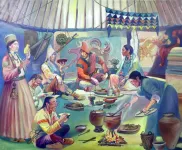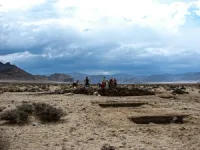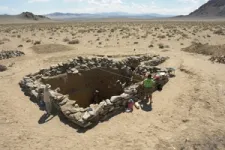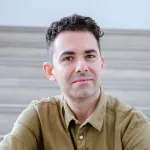(Press-News.org) Long obscured in the shadows of history, the world’s first nomadic empire - the Xiongnu - is at last coming into view thanks to painstaking archaeological excavations and new ancient DNA evidence. Arising on the Mongolian steppe 1,500 years before the Mongols, the Xiongnu empire grew to be one of Iron Age Asia’s most powerful political forces - ultimately stretching its reach and influence from Egypt to Rome to Imperial China. Economically grounded in animal husbandry and dairying, the Xiongnu were famously nomadic, building their empire on the backs of horses. Their proficiency at mounted warfare made them swift and formidable foes, and their legendary conflicts with Imperial China ultimately led to the construction of the Great Wall.
However, unlike their neighbors, the Xiongnu never developed a writing system, and consequently historical records about the Xiongnu have been almost entirely written and passed down by their rivals and enemies. Such accounts, largely recorded by Han Dynasty chroniclers, provide little useful information on the origins of the Xiongnu, their political rise, or their social organization. Although recent archaeogenetics studies have now traced the origins of the Xiongnu as a political entity to a sudden migration and mixing of disparate nomadic groups in northern Mongolia ca. 200 BCE, such findings have raised more questions than answers.
To better understand the inner workings of the seemingly enigmatic Xiongnu empire, an international team of researchers at the Max Planck Institutes for Evolutionary Anthropology (MPI-EVA) and Geoanthropology (MPI-GEO), Seoul National University, the University of Michigan, and Harvard University conducted an in-depth genetic investigation of two imperial elite Xiongnu cemeteries along the western frontier of the empire: an aristocratic elite cemetery at Takhiltyn Khotgor and a local elite cemetery at Shombuuzyn Belchir.
“We knew that the Xiongnu had a high degree of genetic diversity, but due to a lack of community-scale genomic data it remained unclear whether this diversity emerged from a heterogeneous patchwork of locally homogenous communities or whether local communities were themselves genetically diverse,” explains Juhyeon Lee, first author of the study and PhD student at Seoul National University. “We wanted to know how such genetic diversity was structured at different social and political scales, as well as in relation to power, wealth, and gender.”
The rise of a multiethnic empire
Researchers found that individuals within the two cemeteries exhibited extremely high genetic diversity, to a degree comparable with that found across the Xiongnu Empire as a whole. In fact, high genetic diversity and heterogeneity was present at all levels – across the empire, within individual communities, and even within individual families - confirming the characterization of the Xiongnu Empire as a multiethnic empire. However, much of this diversity was stratified by status. The lowest status individuals (interred as satellite burials of the elites, likely reflecting a servant status) exhibited the highest genetic diversity and heterogeneity, suggesting that these individuals originated from far-flung parts of the Xiongnu Empire or beyond. In contrast, local and aristocratic elites buried in wood-plank coffins within square tombs and stone ring graves exhibited lower overall genetic diversity and harbored higher proportions of eastern Eurasian ancestries, suggesting that elite status and power was concentrated among specific genetic subsets of the broader Xiongnu population. Nevertheless, even elite families appear to have used marriage to cement ties to newly incorporated groups, especially at Shombuuzyn Belchir.
“We now have a better idea of how the Xiongnu expanded their empire by incorporating disparate groups and leveraging marriage and kinship into empire building,” says senior author Dr. Choongwon Jeong, Associate Professor of Biological Sciences at Seoul National University.
Powerful women in Xiongnu society
A second major finding was that high status Xiongnu burials and elite grave goods were disproportionately associated with women, corroborating textual and archaeological evidence that Xiongnu women played especially prominent political roles in the expansion and integration of new territories along the empire’s frontier. At the aristocratic elite cemetery of Takhiltyn Khotgor, researchers found that the elite monumental tombs had been built for women, with each prominent woman flanked by a host of commoner males buried in simple graves. The women were interred in elaborate coffins with the golden sun and moon emblems of Xiongnu imperial power and one tomb even contained a team of six horses and a partial chariot. At the nearby local elite cemetery of Shombuuzyn Belchir, women likewise occupied the wealthiest and most elaborate graves, with grave goods consisting of wooden coffins, golden emblems and gilded objects, glass and faience beads, Chinese mirrors, a bronze cauldron, silk clothing, wooden carts, and more than a dozen livestock, as well as three objects conventionally associated with male horse-mounted warriors: a Chinese lacquer cup, a gilded iron belt clasp, and horse tack. Such objects and their symbolism convey the great political power of the women.
“Women held great power as agents of the Xiongnu imperial state along the frontier, often holding exclusive noble ranks, maintaining Xiongnu traditions, and engaging in both steppe power politics and the so-called Silk Road networks of exchange,” says Dr. Bryan Miller, project archaeologist and Assistant Professor of Central Asian Art & Archaeology at the University of Michigan.
Children in Xiongnu society
Genetic analysis also provided rare insights into the social roles of children in Xiongnu society. “Children received differential mortuary treatment depending upon age and sex, giving clues to the ages at which gender and status were ascribed in Xiongnu society,” says senior author Dr. Christina Warinner, Associate Professor of Anthropology at Harvard University and Group Leader at the Max Planck Institute for Evolutionary Anthropology. Researchers found, for example, that although adolescent Xiongnu boys as young as 11-12 years old were buried with a bow and arrows, in a manner resembling that of adult males, younger boys were not. This suggests that the gendered social roles of hunter and warrior were not ascribed to boys until late childhood or early adolescence.
The legacy of the Xiongnu today
Although the Xiongnu empire ultimately disintegrated in the late 1st century CE, the findings of the study point to the enduring social and cultural legacy of the Xiongnu. “Our results confirm the long-standing nomadic tradition of elite princesses playing critical roles in the political and economic life of the empires, especially in periphery regions - a tradition that began with the Xiongnu and continued more than a thousand years later under the Mongol Empire,” says Dr. Jamsranjav Bayarsaikhan, project archaeologist and Mongolian Archaeology Project: Surveying the Steppes (MAPSS) project coordinator at the Max Planck Institute for Geoanthropology. “While history has at times dismissed nomadic empires as fragile and short, their strong traditions have never been broken.”
END
The 2022 eruption of a submarine volcano in Tonga was more powerful than the largest U.S. nuclear explosion, according to a new study led by scientists at the University of Miami Rosenstiel School of Marine, Atmospheric, and Earth Science and the Khaled bin Sultan Living Oceans Foundation.
The 15-megaton volcanic explosion from Hunga Tonga-Hunga Ha'apai, one of the largest natural explosions in more than a century, generated a mega-tsunami with waves up to 45-meters high (148 feet) along the coast of Tonga’s Tofua Island and waves up to 17 meters (56 feet) on Tongatapu, ...
UNIVERSITY PARK, Pa. — New research provides insight into how an enzyme that helps regulate aging and other metabolic processes accesses our genetic material to modulate gene expression within the cell. A team led by Penn State researchers have produced images of a sirtuin enzyme bound to a nucleosome—a tightly packed complex of DNA and proteins called histones—showing how the enzyme navigates the nucleosome complex to access both DNA and histone proteins and clarifying how it functions in humans and other animals.
A paper describing the results appears April 14 in the journal ...
Has potential to help geneticists investigate vital issues such as antibacterial resistance
Will untangle the genetic components shared due to common ancestry from the ones shared due to evolution
The work is result of a four-year international collaboration.
Aston University has worked with international partners to develop a software package to help scientists answer key questions about genetic factors associated with shared characteristics among different species.
Called CALANGO (comparative analysis with annotation-based genomic ...
A new analysis of the carbon footprint of products used in the five most common surgical operations carried out in the NHS in England shows that 68% of carbon contributions come from single-use items, such as single-use gowns, patient drapes and instrument table drapes. Published by the Journal of the Royal Society of Medicine, the analysis highlights significant carbon contributors were the production of single use items and their waste disposal, together with processes for decontaminating reusable products.
Researchers ...
ROCKVILLE, Md.—New research shows that several anti-obesity medications could be manufactured and profitability sold worldwide at far lower estimated lower prices compared to their high costs, according to a new study in Obesity, The Obesity Society’s (TOS) flagship journal.
“Access to medicine is a fundamental element of the human right to health. While the obesity pandemic grows, especially amongst low-income communities, effective medical treatments remain inaccessible for millions in need. Our study highlights the inequality in pricing that exists for effective anti-obesity medications, ...
BOSTON – New research from Boston Medical Center concluded that offering medications to treat opioid addiction in jails and prisons leads to a decrease in overdose deaths. Published in JAMA Network Open, the study also found that treating opioid addiction during incarceration is cost-effective in terms of healthcare costs, incarceration costs, and deaths avoided.
Overdoses kill more than 100,000 people per year in America and this number continues to increase every year. People with addiction are more likely to be incarcerated than treated, with those from communities of color who use drugs more likely to be incarcerated than ...
The objective of the Activity Group on Financial Mathematics and Engineering is to advance fundamental research and implementation of practices in financial engineering, computation, and operations. The group aims at fostering collaborations among applied mathematicians, applied probabilists, statisticians, computer and data scientists, economists, as well as industry practitioners. The conference will expose state-of-art mathematical and computational tools in quantitative finance, including its uses in the public and private sector. The activity group promotes and supports the development of financial mathematics and engineering as an academic discipline. END ...
Certain ambrosia beetles species engage in active agriculture. As social communities, they breed and care for food fungi in the wood of trees and ensure that so-called weed fungi spread less. Researchers led by Prof. Dr. Peter Biedermann, professor of Forest Entomology and Forest Protection at the University of Freiburg, now demonstrate for the first time that ambrosia beetles can distinguish between different species of fungi by their scents. "The results can contribute to a better understanding of why beetles selectively colonise trees with conspecifics and how ...
Study: "Following the Letter of the Law: 2020–2021 Retention Outcomes Under Michigan’s Read by Grade Three Law"
Authors: Andrew Niel Utter (Michigan State University), John Westall (Michigan State University), Katharine O. Strunk (Michigan State University)
Embargoed until: 12:01 a.m. CT Friday, April 14
This study will be presented at the place-based component of the 2023 Annual Meeting of the American Educational Research Association.
Session: Minding the Gap in Accountability Policy Implementation
Date/Time: Friday, April 14, 2:50 p.m. – 4:20 p.m. CT
Main Findings:
Under Michigan’s “Read by Grade ...
With the goal of fostering awareness and identifying strategies to reduce bias within the medical genetics field and to improve health equity, members of the ACMG’s Social, Ethical and Legal Issues (SELI) and Diversity, Equity and Inclusion (DEI) Committees collaborated to address factors in which bias can occur in clinical genetic testing in a just-published statement, “Clinical, technical, and environmental biases influencing equitable access to clinical genetics/genomics testing: A points to consider statement of the American College of Medical Genetics and Genomics (ACMG)”.
This is the first joint statement of the ACMG’s ...






